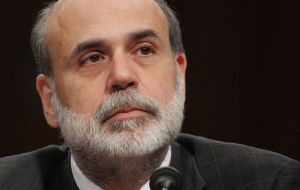MercoPress. South Atlantic News Agency
Fed warns investors to be prepared for an easing out of stimuli later in the year
 “It would be appropriate to moderate the monthly pace of purchases later this year” said Bernanke
“It would be appropriate to moderate the monthly pace of purchases later this year” said Bernanke United States Federal Reserve Chairman Ben Bernanke is putting investors on notice that the central bank is prepared to begin phasing out easing programs later this year.
The Fed will probably taper its 85 billion dollars in monthly bond buying later in 2013 and halt purchases around mid-2014 as long as the world’s largest economy performs in line with Fed projections, Bernanke said to reporters on Wednesday in Washington after a two-day meeting of the Federal Open Market Committee.
Stocks and Treasuries tumbled at the prospect of a wind-down in bond buying that’s swollen the Fed balance sheet to a record 3.41 trillion in an attack against the worst joblessness since the Great Depression. While citing waning risks to the economy, Bernanke said curbs to bond buying hinge on gains in the labour market and a pickup in growth.
The conclusion to record stimulus may take years to complete as the Fed’s forecasts showed most officials don’t expect to begin raising the benchmark lending rate out of its lowest-ever range of zero to 0.25% until 2015.
However Bernanke warned investors against viewing the policy makers’ plans as inflexible, saying their decisions are not “deterministic.”
“If the incoming data are broadly consistent with this forecast, the committee currently anticipates that it would be appropriate to moderate the monthly pace of purchases later this year,” Bernanke said, referring to the FOMC’s outlook for “moderate” economic growth, further labour-market gains and inflation accelerating toward the Fed’s 2% goal.
If such gains are maintained, “we would continue to reduce the pace of purchases in measured steps through the first half of next year, ending purchases around mid-year” he said. A “strong majority” on the FOMC now expects it won’t sell mortgage-backed securities as part of their exit strategy.
The chairman’s description of the end of quantitative easing indicates that Fed officials see the economy finally healing from a burst credit bubble that deflated housing prices by 35% over almost six years, left one in 10 American workers unemployed in October 2009 and prompted the biggest overhaul of financial regulation since the 1930s.
The U.S. central bank began its third round of large-scale asset purchases in September by buying 40 billion a month of mortgage-backed securities. The Fed added 45 billion of Treasury purchases in December. The FOMC has said since September that it will buy bonds until seeing signs of substantial labour-market improvement.
The FOMC’s forecasts show the US economy needs to cross some hurdles before meeting the criteria for a slowing of bond purchases. Officials expect the economy to grow 3% to 3.5% next year, driving the unemployment rate down to 6.5% to 6.8% from 7.6% in May, according to their central tendency estimates, which exclude the three highest and three lowest.




Top Comments
Disclaimer & comment rules-

Read all commentsI don't think Bernanke has the least clue about the US economy and never has.
Jun 20th, 2013 - 10:26 pm 0And we will see it all fall down when the tit runs dry. The US and the UK, et al, have wasted years avoiding the correction that was always going to come.
Mr. Market will kick the balls of all these experts, you see if he doesn't.
Commenting for this story is now closed.
If you have a Facebook account, become a fan and comment on our Facebook Page!